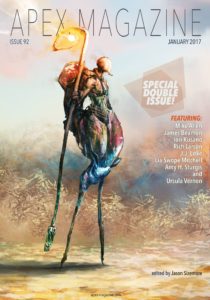A few months ago, Apex Publications invited me to be part of their Back Catalogue Blog Tour. I chose to write a book review for Chesya Burke’s Let’s Play White as my contribution to it. Other participants will be sharing author interviews and guest posts throughout this month, so click the link above to check them out.

Title: Let’s Play White
Author: Chesya Burke
Publisher: Apex Publications
Publication Date: 2011
Genres: Science Fiction, Horror, Contemporary, Historical
Length: 200 pages
Source: I received a free copy from Apex Publications.
Rating: 4.5 Stars
Blurb:
White brings with it dreams of respect, of wealth, of simply being treated as a human being. It’s the one thing Walter will never be. But what if he could play white, the way so many others seem to do? Would it bring him privilege or simply deny the pain? The title story in this collection asks those questions, and then moves on to challenge notions of race, privilege, personal choice, and even life and death with equal vigor.
From the spectrum spanning despair and hope in “What She Saw When They Flew Away” to the stark weave of personal struggles in “Chocolate Park,” Let’s Play White speaks with the voices of the overlooked and unheard. “I Make People Do Bad Things” shines a metaphysical light on Harlem’s most notorious historical madame, and then, with a deft twist into melancholic humor, “Cue: Change” brings a zombie-esque apocalypse, possibly for the betterment of all mankind.
Gritty and sublime, the stories of Let’s Play White feature real people facing the worlds they’re given, bringing out the best and the worst of what it means to be human. If you’re ready to slip into someone else’s skin for a while, then it’s time to come play white.
Review:
Content Warning: racism, pregnancy, childbirth, deaths (including the death of a child), rape, domestic violence, and miscarriage. This will otherwise be a spoiler-free post, and I will not be going into detail about any of these topics in my review.
As much as I’d love to write a full-length review of all eleven stories in this anthology, doing so would have inflated this post to five or six thousand words at minimum because each one was set in its own unique universe. What I decided to do instead was to pick a few of the stories I enjoyed the most and talk about why I liked them so much. If any of these mini-reviews catches you attention, I highly recommend reading the whole anthology! It was well done and pretty interesting to read.
Purse
In “Purse,” a woman named Manyara battled anxious thoughts about the other passengers on the bus she was travelling on, especially when it came to a black man who was sitting near her. She was carrying thousands of dollars in her purse and worried she’d be robbed. This tale was filled with creative plot twists, so I’ll need to be mindful of what else I say about it.
What impressed me the most was how much effort I had to put in as a reader to figure out what was really happening on this bus ride. There was so much more going on with Manyara than she originally shared with the audience. This is something I’d recommend reading with as few assumptions about what is happening as your brain can handle.
What She Saw When They Flew Away
Grief doesn’t always end on a set schedule. Pearl, the main character of “What She Saw When They Flew Away,” had suffered a terrible loss before this tale began. Not only did she struggle to come to terms with it, she had even more trouble helping her daughter, Nayja, adapt to their new life together. Their sometimes-conflicting reactions to the same tragedy made me wonder what would happen by the final scene.
While I can’t say much else about their lives without giving away spoilers, I loved the metaphors Pearl used to explain how she was feeling even though I do wish she’d been given more time to show how they affected her life instead of simply telling the audience they were bringing up bittersweet memories.
Cue: Change
As the blurb mentioned, “Cue: Change” was set in a zombiepocalypse. These weren’t typical zombies, though, and their unpredictable effect on society was something I couldn’t have predicted ahead of time. I was fascinated by this twist on this monster. It was completely different from any other take on them I’ve read before, and it made me wish for more stories like this.
The humans also didn’t behave the way I’d normally expect them to in this sub-genre. Not only did they make calm, rational decisions, they stuck to their regular routines as much as they possibly could. This isn’t a common reaction to zombies, and it made me wish this was a full-length novel so I could get to know the characters even better than I did.

 This post is part of the
This post is part of the  Lesley Conner is a writer/editor, managing editor of Apex Publications and Apex Magazine, and a Girl Scout leader. When she isn’t handling her editorial or Girl Scout leader responsibilities, she’s researching fascinating historical figures, rare demons, and new ways to dispose of bodies, interweaving the three into strange and horrifying tales. Her short fiction can be found in Mountain Dead, Dark Tales of Terror, A Hacked-Up Holiday Massacre, as well as other places. Her first novel The Weight of Chains was published by Sinister Grin Press in September, 2015. Best of Apex Magazine: Volume 1 marks her debut experience in anthology editing. She lives in Maryland with her husband and two daughters, and is currently working on a new novel. To find out all her secrets, you can follow her on Twitter at @LesleyConner.
Lesley Conner is a writer/editor, managing editor of Apex Publications and Apex Magazine, and a Girl Scout leader. When she isn’t handling her editorial or Girl Scout leader responsibilities, she’s researching fascinating historical figures, rare demons, and new ways to dispose of bodies, interweaving the three into strange and horrifying tales. Her short fiction can be found in Mountain Dead, Dark Tales of Terror, A Hacked-Up Holiday Massacre, as well as other places. Her first novel The Weight of Chains was published by Sinister Grin Press in September, 2015. Best of Apex Magazine: Volume 1 marks her debut experience in anthology editing. She lives in Maryland with her husband and two daughters, and is currently working on a new novel. To find out all her secrets, you can follow her on Twitter at @LesleyConner.